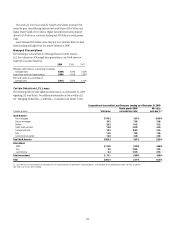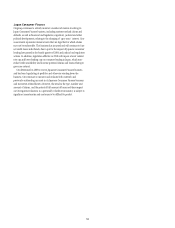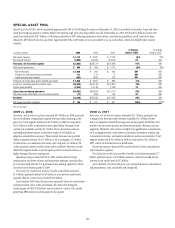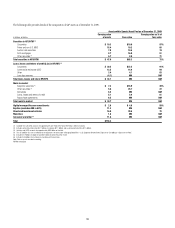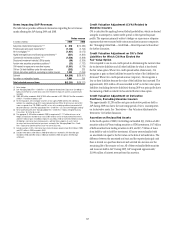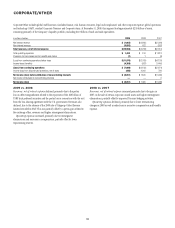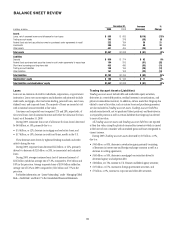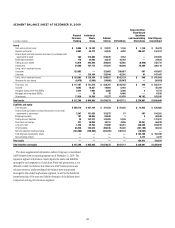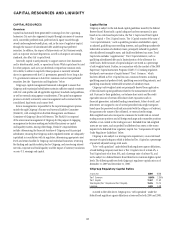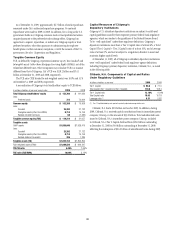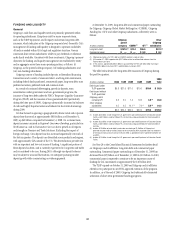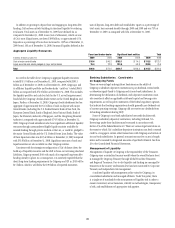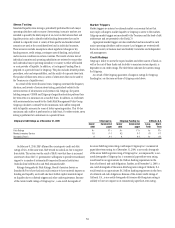Citibank 2009 Annual Report Download - page 53
Download and view the complete annual report
Please find page 53 of the 2009 Citibank annual report below. You can navigate through the pages in the report by either clicking on the pages listed below, or by using the keyword search tool below to find specific information within the annual report.
43
CAPITAL RESOURCES AND LIQUIDITY
CAPITAL RESOURCES
Overview
Capital has historically been generated by earnings from Citi’s operating
businesses. Citi may also augment its capital through issuances of common
stock, convertible preferred stock, preferred stock, equity issued through
awards under employee benefit plans, and, in the case of regulatory capital,
through the issuance of subordinated debt underlying trust preferred
securities. In addition, the impact of future events on Citi’s business results,
such as corporate and asset dispositions, as well as changes in accounting
standards, also affect Citi’s capital levels.
Generally, capital is used primarily to support assets in Citi’s businesses
and to absorb market, credit, or operational losses. While capital may be used
for other purposes, such as to pay dividends or repurchase common stock,
Citi’s ability to utilize its capital for these purposes is currently restricted
due to its agreements with the U.S. government, generally for so long as the
U.S. government continues to hold Citi’s common stock or trust preferred
securities. See also “Supervision and Regulation” below.
Citigroup’s capital management framework is designed to ensure that
Citigroup and its principal subsidiaries maintain sufficient capital consistent
with Citi’s risk profile and all applicable regulatory standards and guidelines,
as well as external rating agency considerations. The capital management
process is centrally overseen by senior management and is reviewed at the
consolidated, legal entity, and country level.
Senior management is responsible for the capital management process
mainly through Citigroup’s Finance and Asset and Liability Committee
(FinALCO), with oversight from the Risk Management and Finance
Committee of Citigroup’s Board of Directors. The FinALCO is composed
of the senior-most management of Citigroup for the purpose of engaging
management in decision-making and related discussions on capital
and liquidity matters. Among other things, FinALCO’s responsibilities
include: determining the financial structure of Citigroup and its principal
subsidiaries; ensuring that Citigroup and its regulated entities are adequately
capitalized in consultation with its regulators; determining appropriate asset
levels and return hurdles for Citigroup and individual businesses; reviewing
the funding and capital markets plan for Citigroup; and monitoring interest
rate risk, corporate and bank liquidity, and the impact of currency translation
on non-U.S. earnings and capital.
Capital Ratios
Citigroup is subject to the risk-based capital guidelines issued by the Federal
Reserve Board. Historically, capital adequacy has been measured, in part,
based on two risk-based capital ratios, the Tier 1 Capital and Total Capital
(Tier 1 Capital + Tier 2 Capital) ratios. Tier 1 Capital consists of the sum of
“core capital elements,” such as qualifying common stockholders’ equity,
as adjusted, qualifying noncontrolling interests, and qualifying mandatorily
redeemable securities of subsidiary trusts, principally reduced by goodwill,
other disallowed intangible assets, and disallowed deferred tax assets. Total
Capital also includes “supplementary” Tier 2 Capital elements, such as
qualifying subordinated debt and a limited portion of the allowance for
credit losses. Both measures of capital adequacy are stated as a percentage
of risk-weighted assets. Further, in conjunction with the conduct of the 2009
Supervisory Capital Assessment Program (SCAP), U.S. banking regulators
developed a new measure of capital termed “Tier 1 Common,” which
has been defined as Tier 1 Capital less non-common elements, including
qualifying perpetual preferred stock, qualifying noncontrolling interests, and
qualifying mandatorily redeemable securities of subsidiary trusts.
Citigroup’s risk-weighted assets are principally derived from application
of the risk-based capital guidelines related to the measurement of credit
risk. Pursuant to these guidelines, on-balance-sheet assets and the credit
equivalent amount of certain off-balance-sheet exposures (such as
financial guarantees, unfunded lending commitments, letters of credit, and
derivatives) are assigned to one of several prescribed risk-weight categories
based upon the perceived credit risk associated with the obligor, or if relevant,
the guarantor, the nature of the collateral, or external credit ratings.
Risk-weighted assets also incorporate a measure for market risk on covered
trading account positions and all foreign exchange and commodity positions
whether or not carried in the trading account. Excluded from risk-weighted
assets are any assets, such as goodwill and deferred tax assets, to the extent
required to be deducted from regulatory capital. See “Components of Capital
Under Regulatory Guidelines” below.
Citigroup is also subject to a Leverage ratio requirement, a non-risk-based
measure of capital adequacy, which is defined as Tier 1 Capital as a percentage
of quarterly adjusted average total assets.
To be “well capitalized” under federal bank regulatory agency definitions,
a bank holding company must have a Tier 1 Capital ratio of at least 6%, a
Total Capital ratio of at least 10%, and a Leverage ratio of at least 3%, and
not be subject to a Federal Reserve Board directive to maintain higher capital
levels. The following table sets forth Citigroup’s regulatory capital ratios as of
December 31, 2009 and December 31, 2008.
Citigroup Regulatory Capital Ratios
At year end 2009 2008
Tier 1 Common 9.60% 2.30%
Tier 1 Capital 11.67 11.92
Total Capital (Tier 1 Capital and Tier 2 Capital) 15.25 15.70
Leverage 6.89 6.08
As noted in the table above, Citigroup was “well capitalized” under the
federal bank regulatory agency definitions at year end for both 2009 and 2008.


